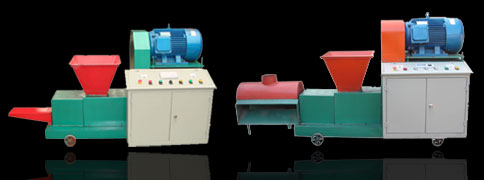Briquetting Presses Technology
Many of the developing countries produce huge quantities of agro residues but they are used inefficiently causing extensive pollution to the environment. The major residues are rice husk, coffee husk, coir pith, jute sticks, bagasse, groundnut shells, mustard stalks and cotton stalks. Sawdust, a milling residue is also available in huge quantity. Apart from the problems of transportation, storage, and handling, the direct burning of loose biomass in conventional grates is associated with very low thermal efficiency and widespread air pollution. The conversion efficiencies are as low as 40% with particulate emissions in the flue gases in excess of 3000 mg/ Nm3. In addition, a large percentage of unburned carbonaceous ash has to be disposed of. In the case of rice husk, this amounts to more than 40% of the feed burnt. As a typical example, about 800 tones of rice husk ash are generated every day in Ludhiana (Punjab) as a result of burning 2000 tones of husk. Briquetting of the husk could mitigate these pollution problems while at the same time making use of this important industrial/domestic energy resource.
Historically, biomass briquetting technology has been developed in two distinct directions. Europe and the United States has pursued and perfected the reciprocating ram/piston press while Japan has independently invented and developed the screw press technology. Although both technologies have their merits and demerits, it is universally accepted that the screw pressed briquettes are far superior to the ram pressed solid briquettes in terms of their storability and combustibility. Japanese machines are now being manufactured in Europe under licensing agreement but no information has been reported about the manufacturing of European machines in Japan.
Biomass densification, which is also known as briquetting of sawdust and other agro residues, has been practiced for many years in several countries. Screw extrusion briquetting technology was invented and developed in Japan in 1945. As of April 1969, there were 638 plants in Japan engaged in manufacturing sawdust briquettes, known as 'Ogalite', amounting to a production of 0.81 MTY. The fact that the production of briquettes quadrupled from 1964 to 1969 in Japan speaks for the success of this technology. This technology should be differentiated from such processes as the 'Prest-o-log' technology of the United States, the 'Glomera' method in Switzerland and the 'Compress' method in West Germany.
At present two main high pressure technologies: ram or piston press and screw extrusion machines, are used for briquetting. While the briquettes produced by a piston press are completely solid, screw press briquettes on the other hand have a concentric hole which gives better combustion characteristics due to a larger specific area. The screw press briquettes are also homogeneous and do not disintegrate easily. Having a high in boilers.
Briquettes can be produced with a density of 1.2 g/cm3 from loose biomass of bulk density 0.1 to 0.2 g / cm3. These can be burnt clean and therefore are eco-friendly arid also those advantages that are associated with the use of biomass are present in the briquettes.
Both national and international agencies have funded projects to improve the existing briquetting technology. The two major impediments for the smooth working of the screw press -- the high wear of the screw and the comparatively large specific power consumption required --were overcome by incorporating biomass feet preheating into the production process. The recent successes in briquetting technology and the growing number of entrepreneurs in the briquetting sector, are evidence that biomass briquetting will emerge as a promising option for the new entrepreneurs and other users of biomass.


